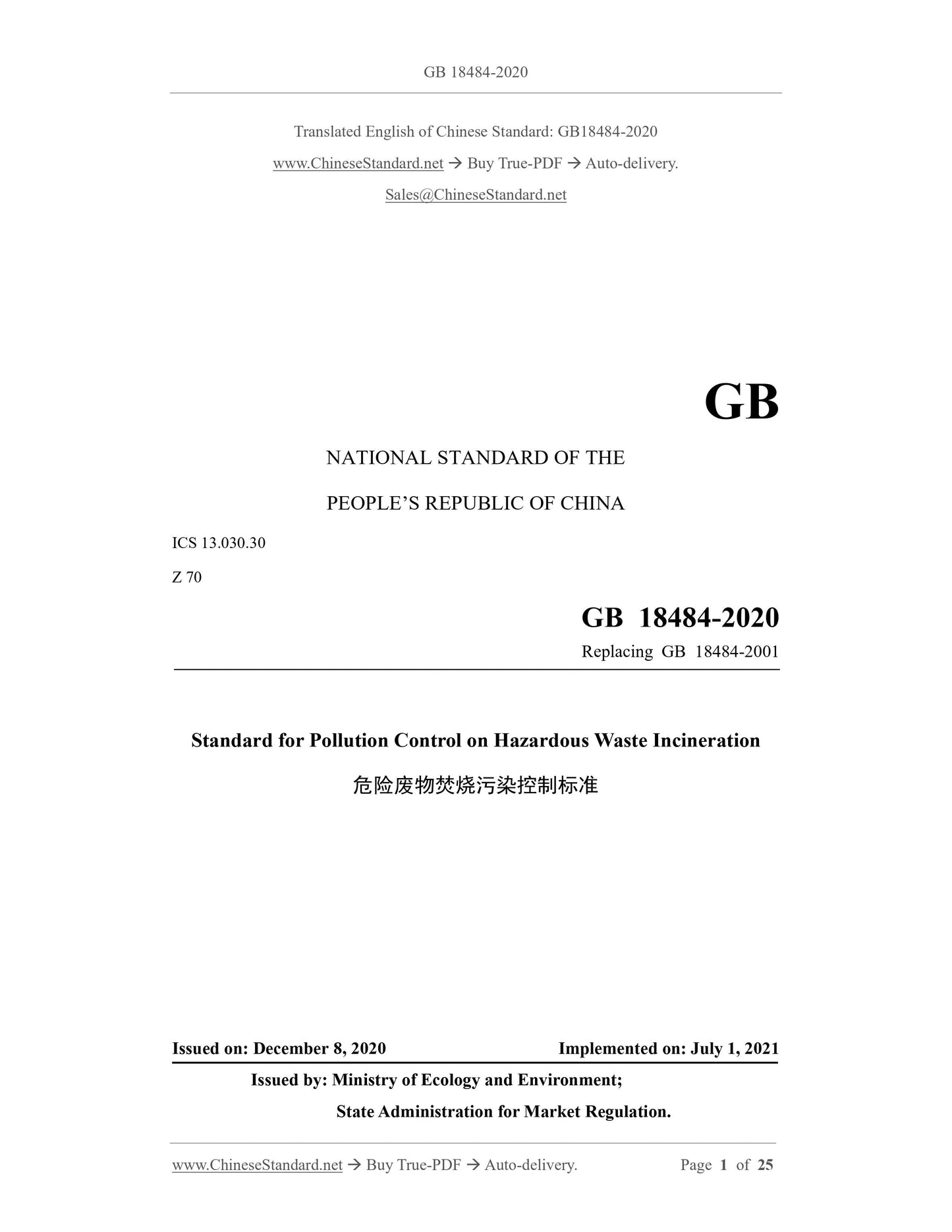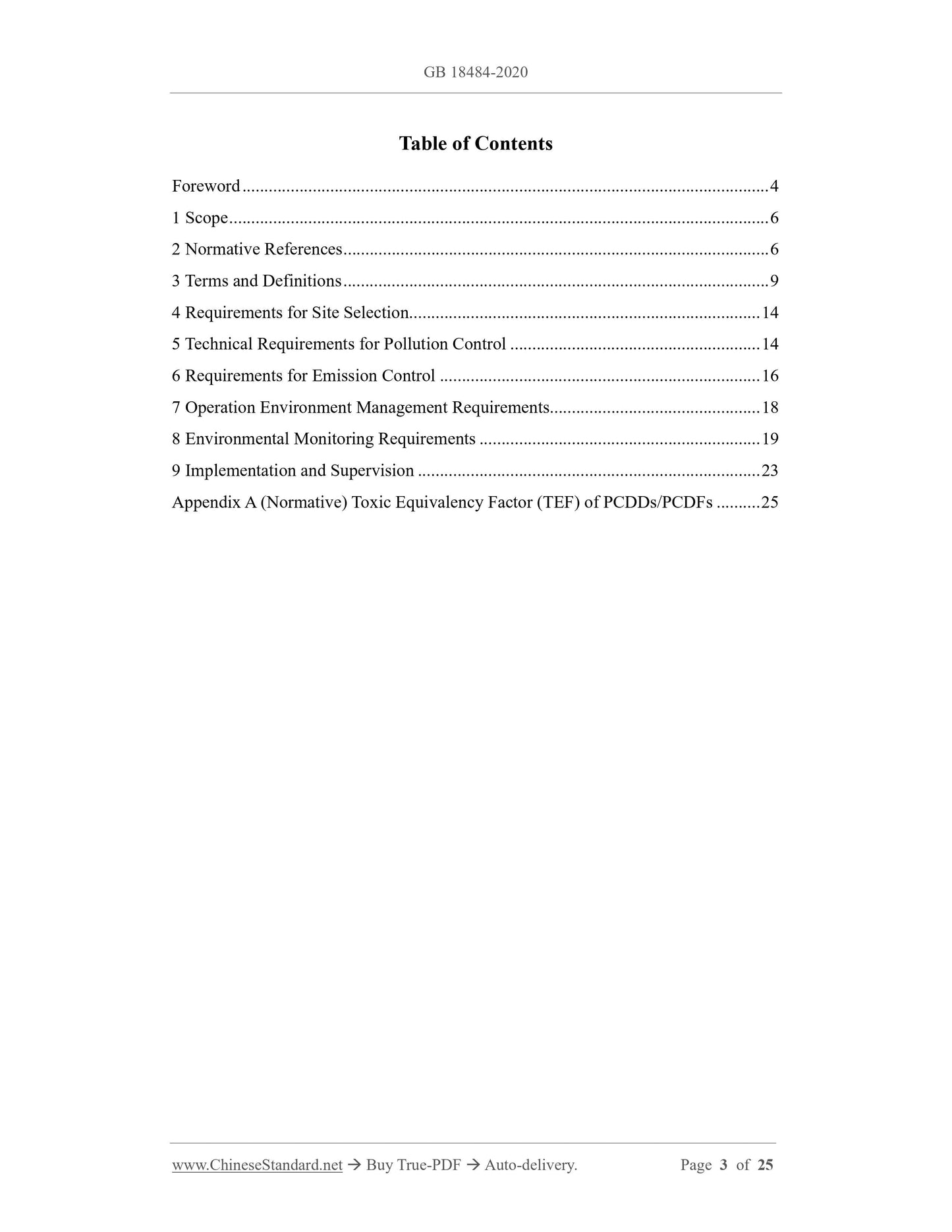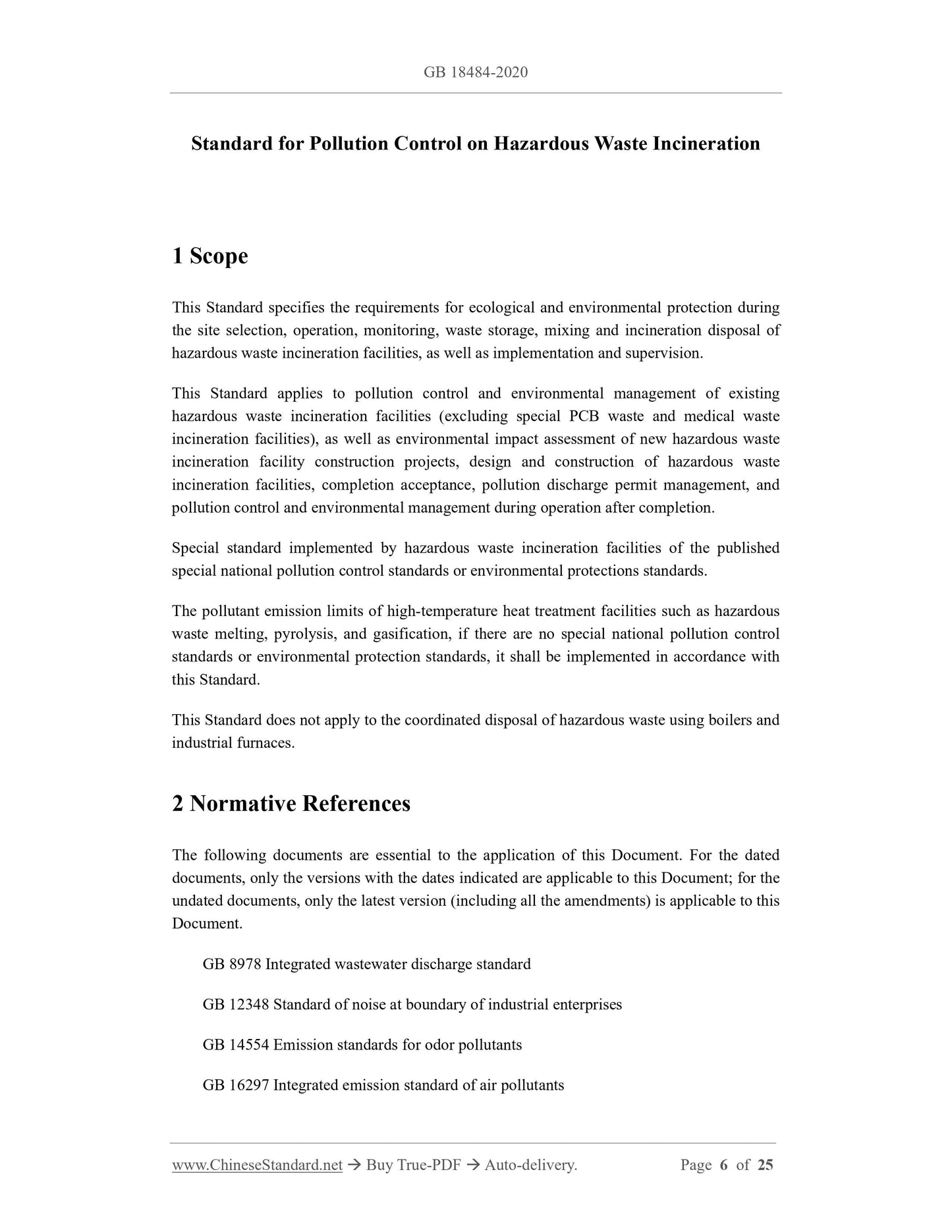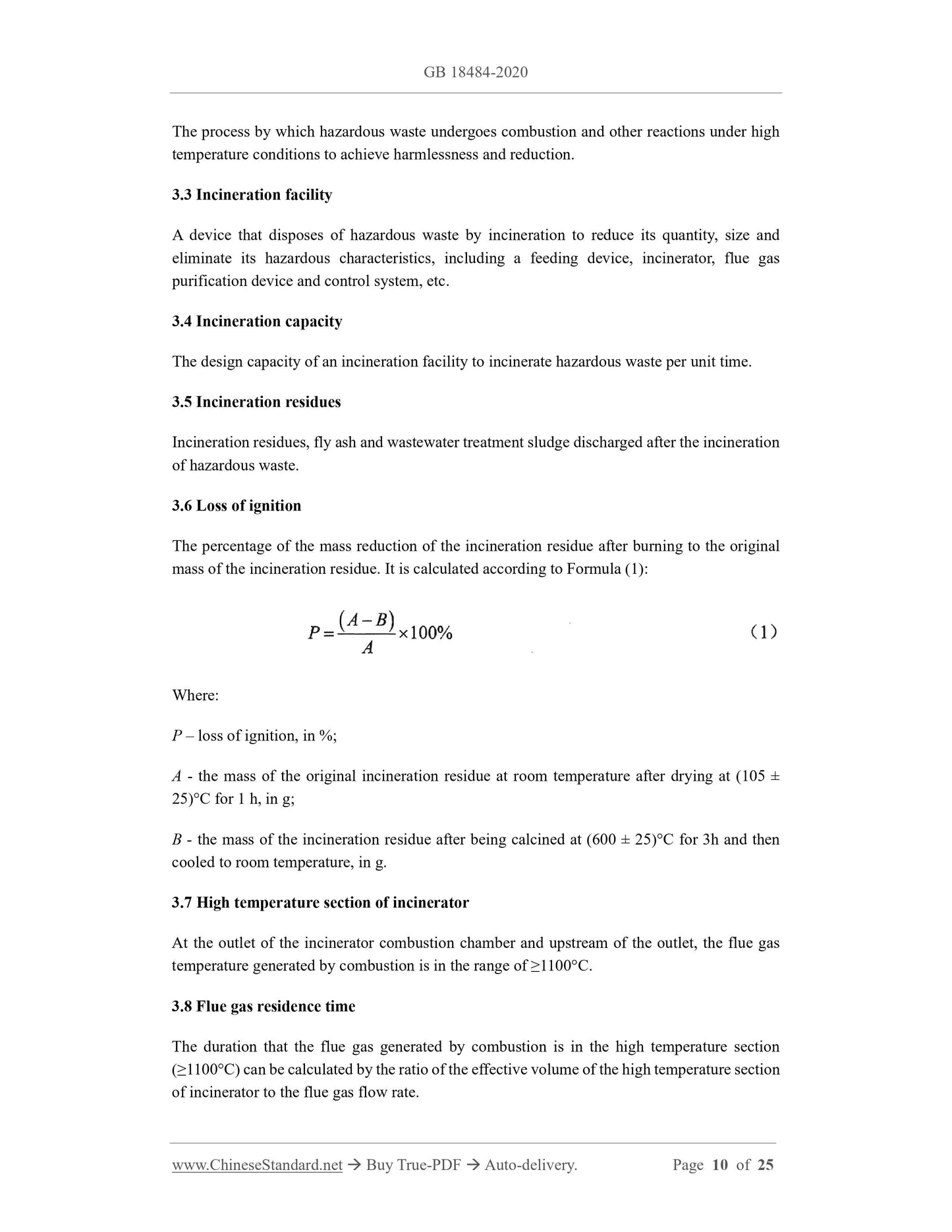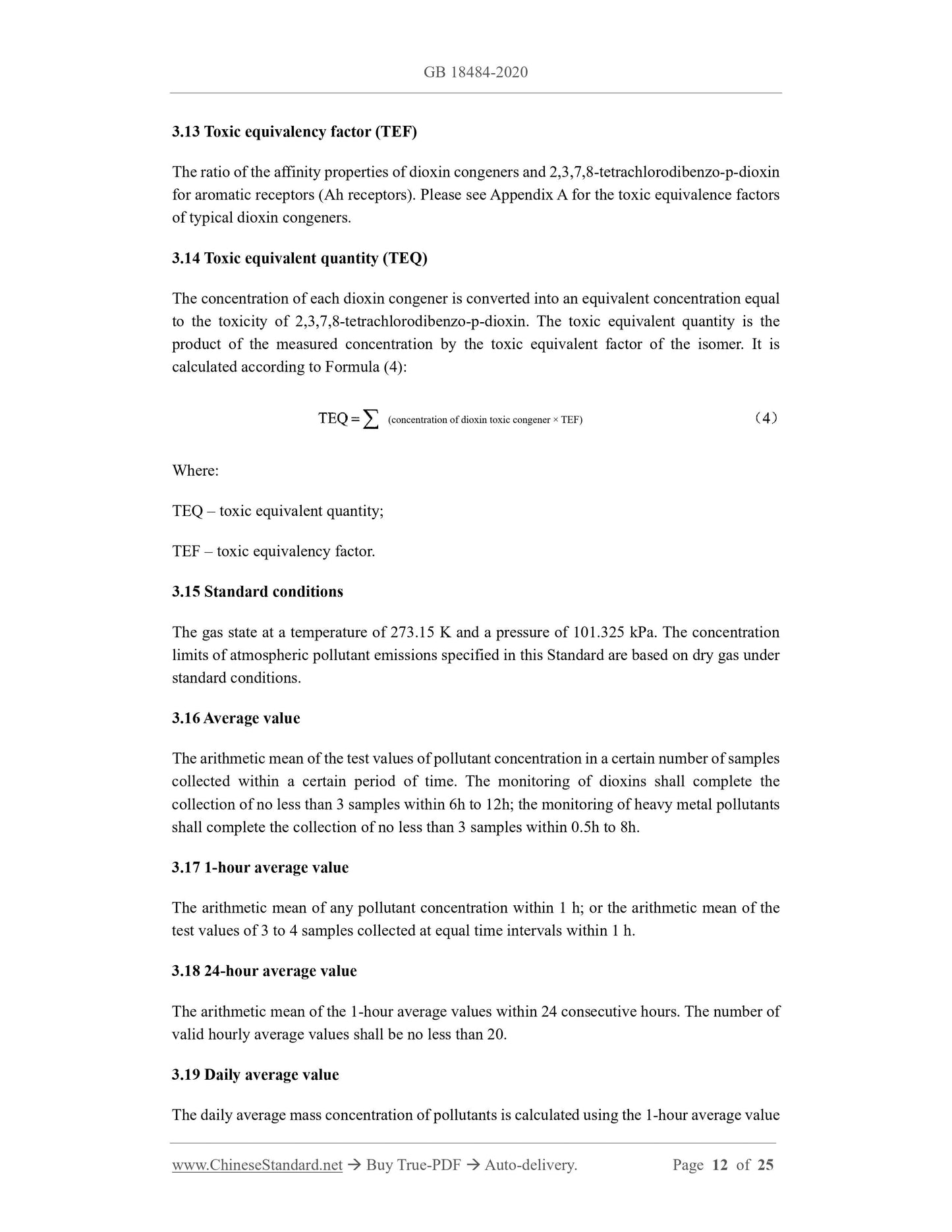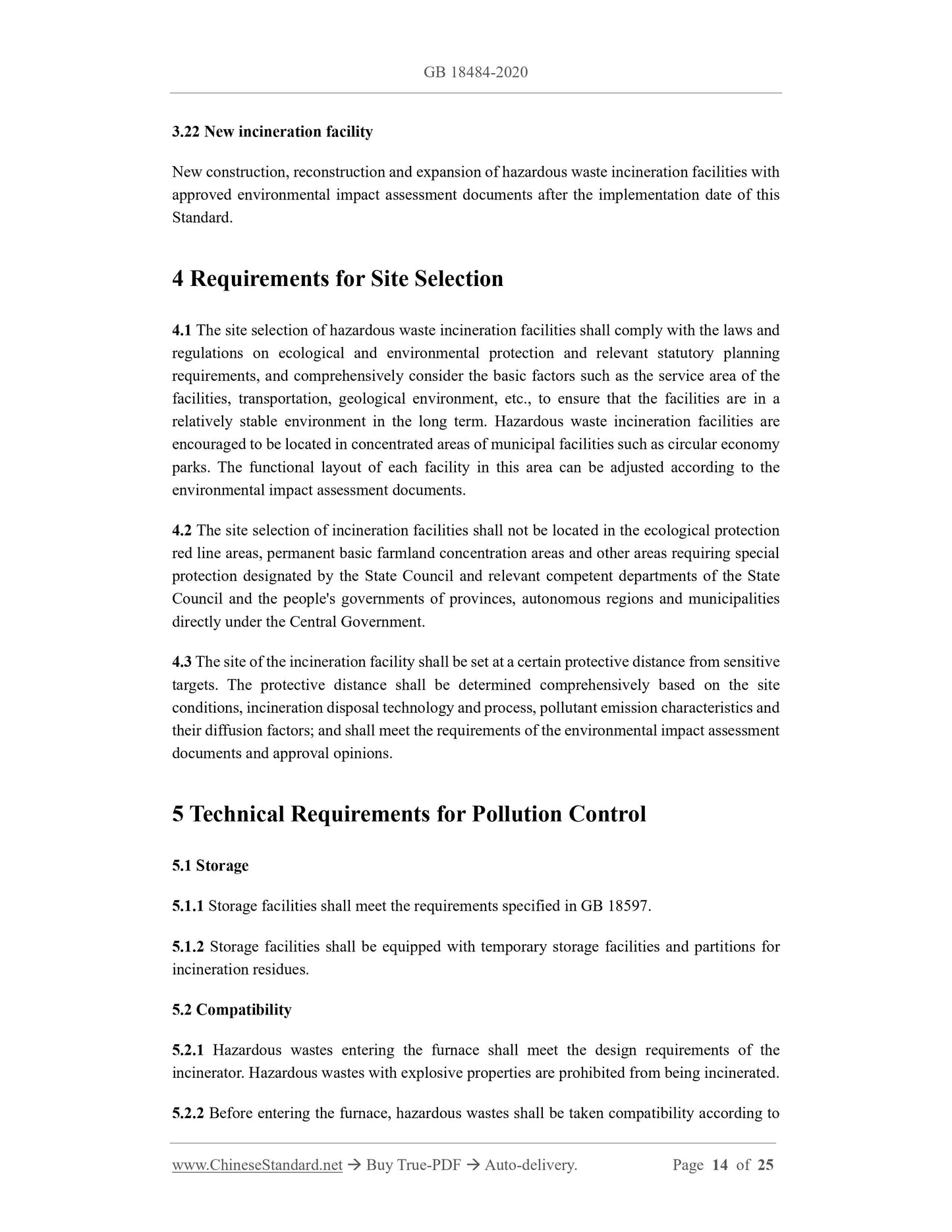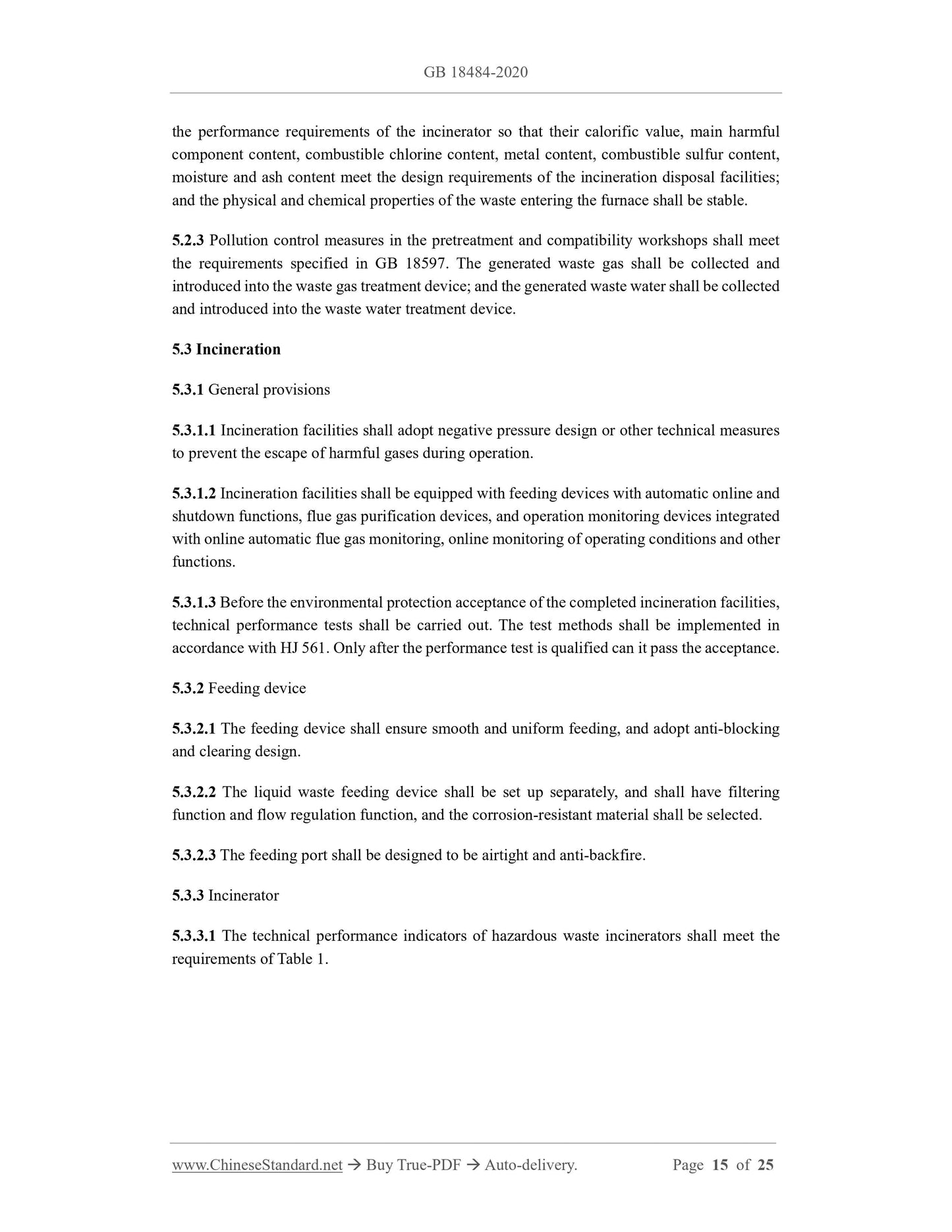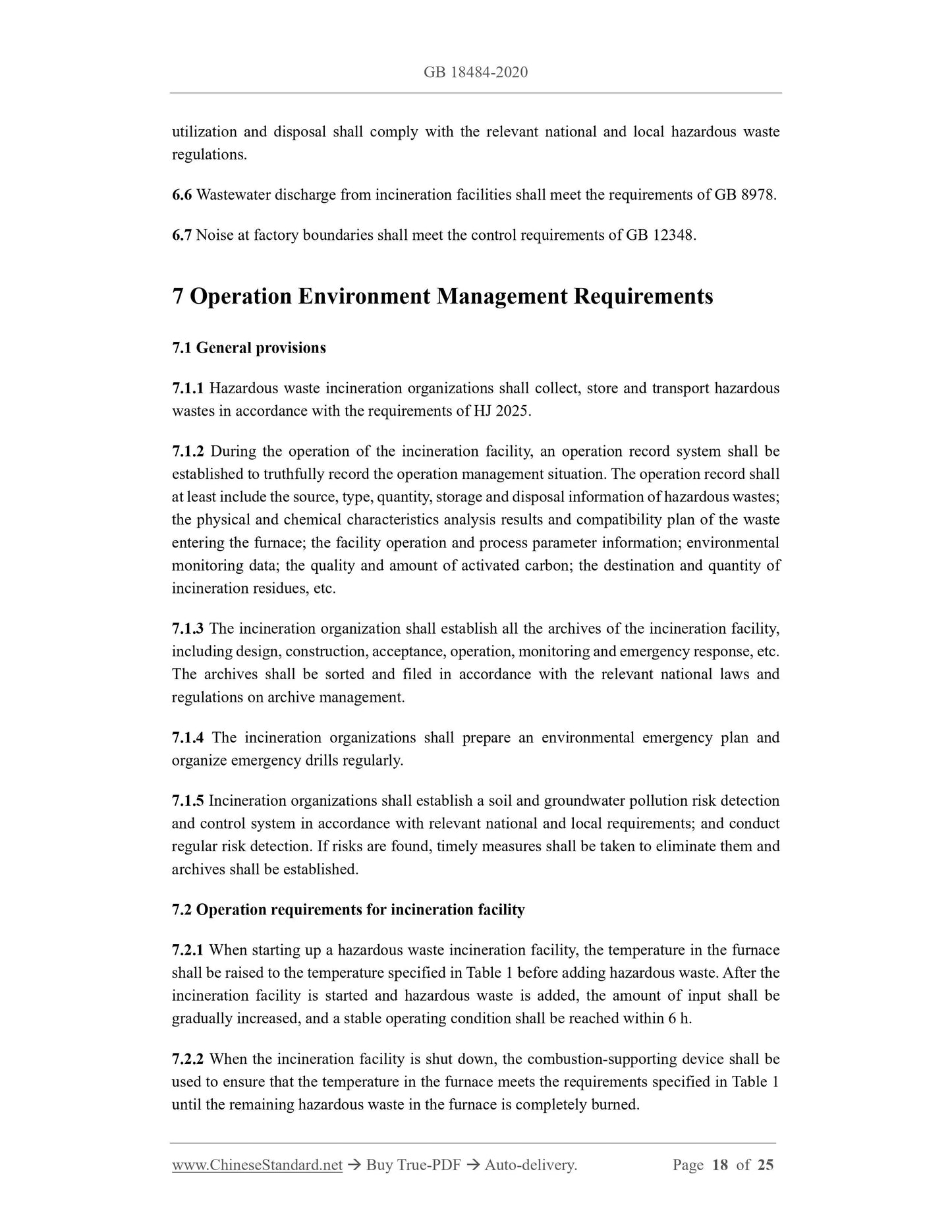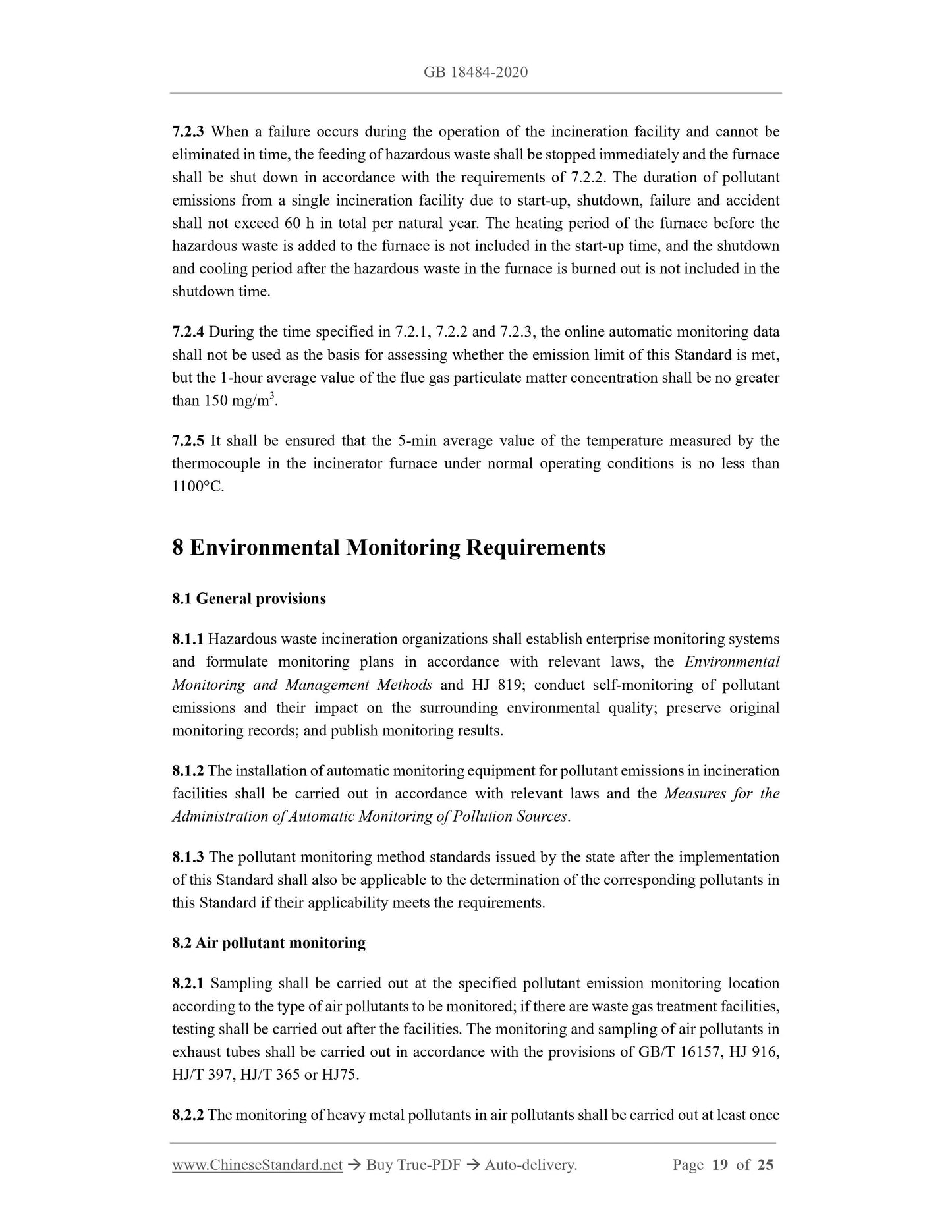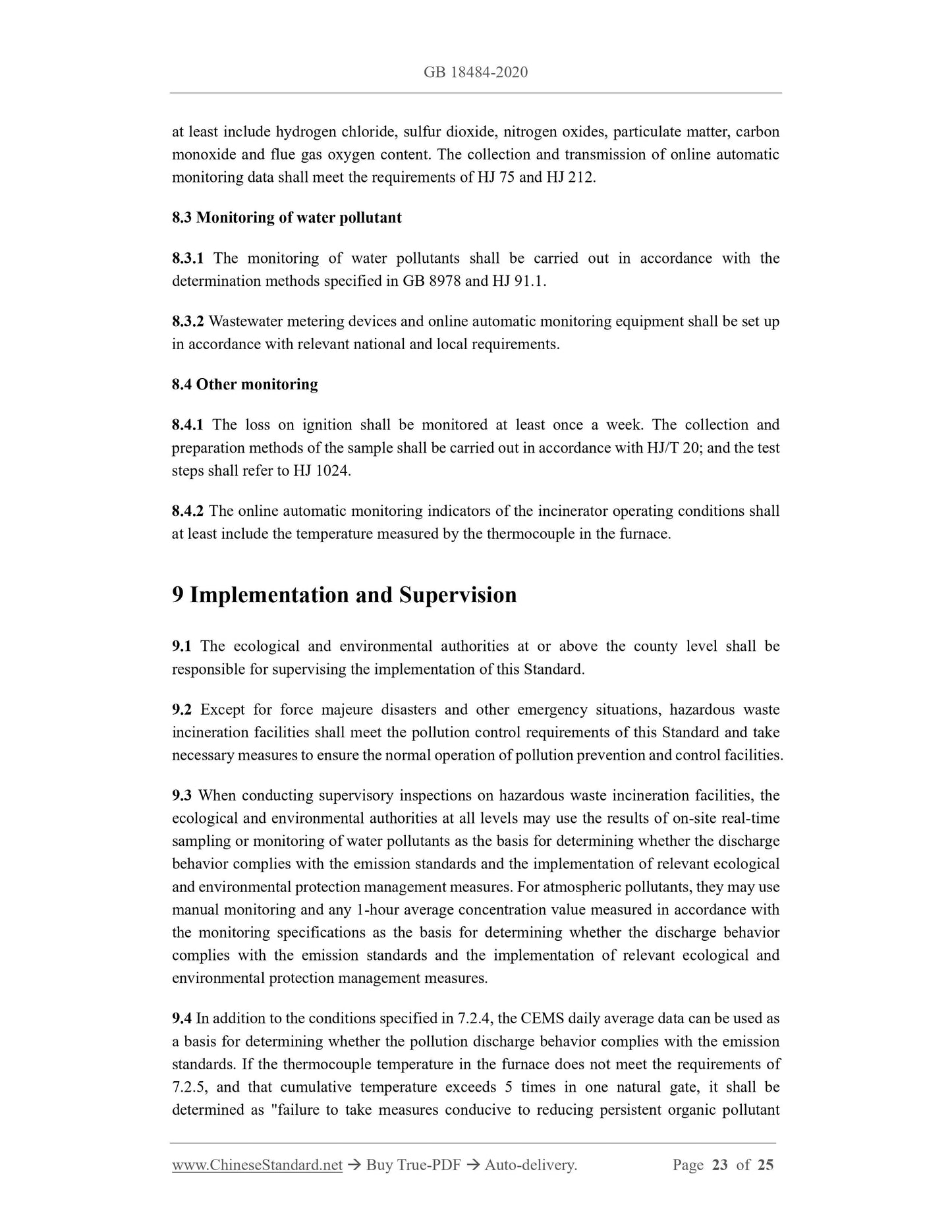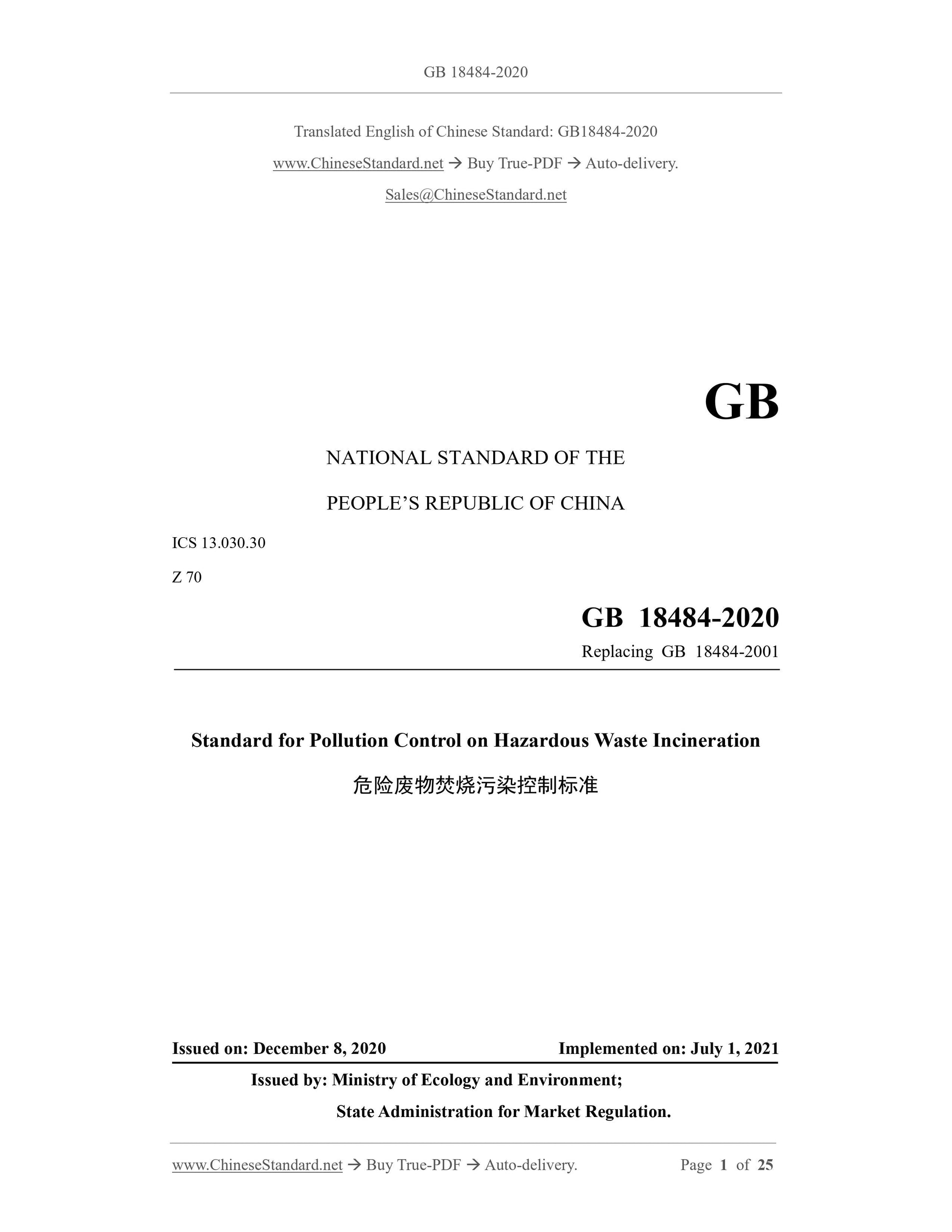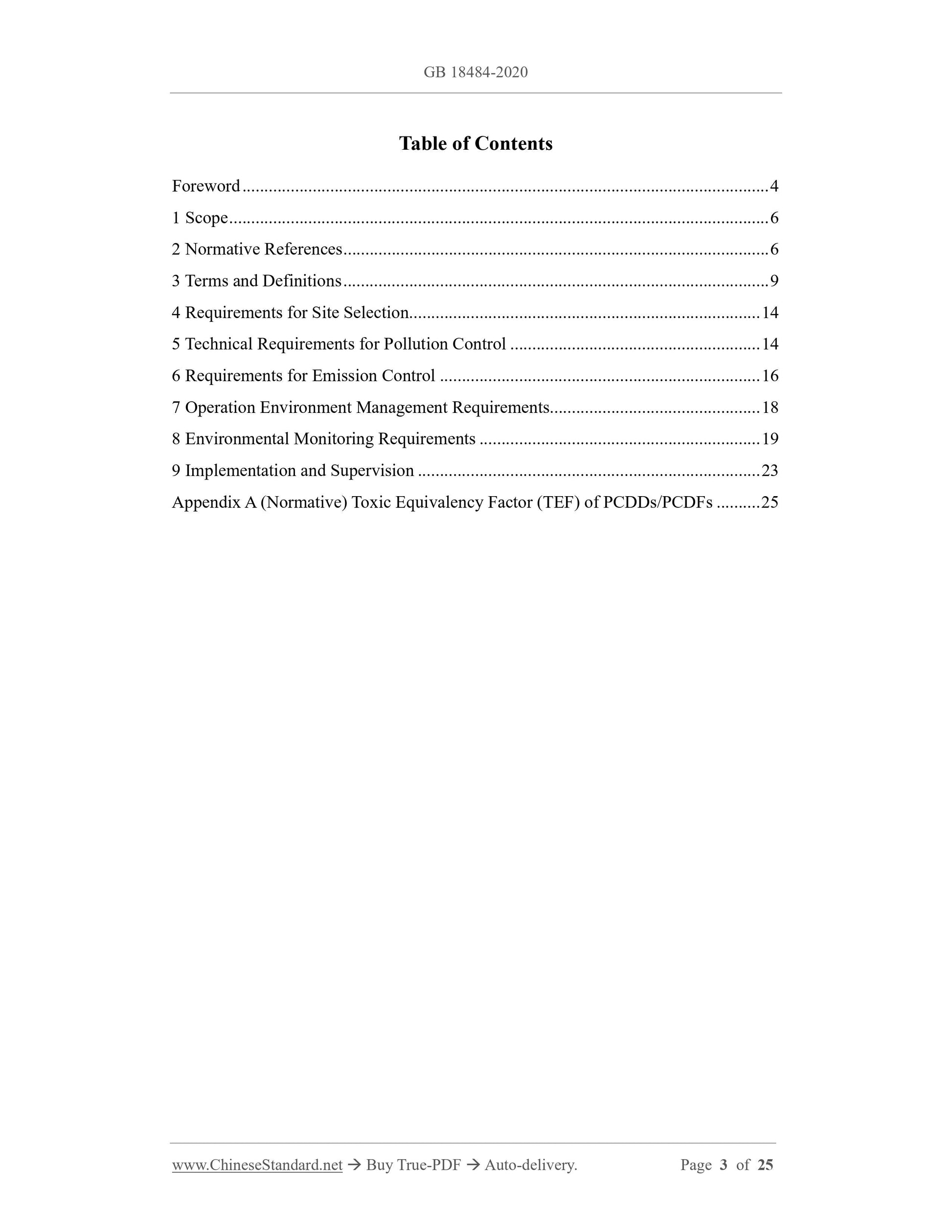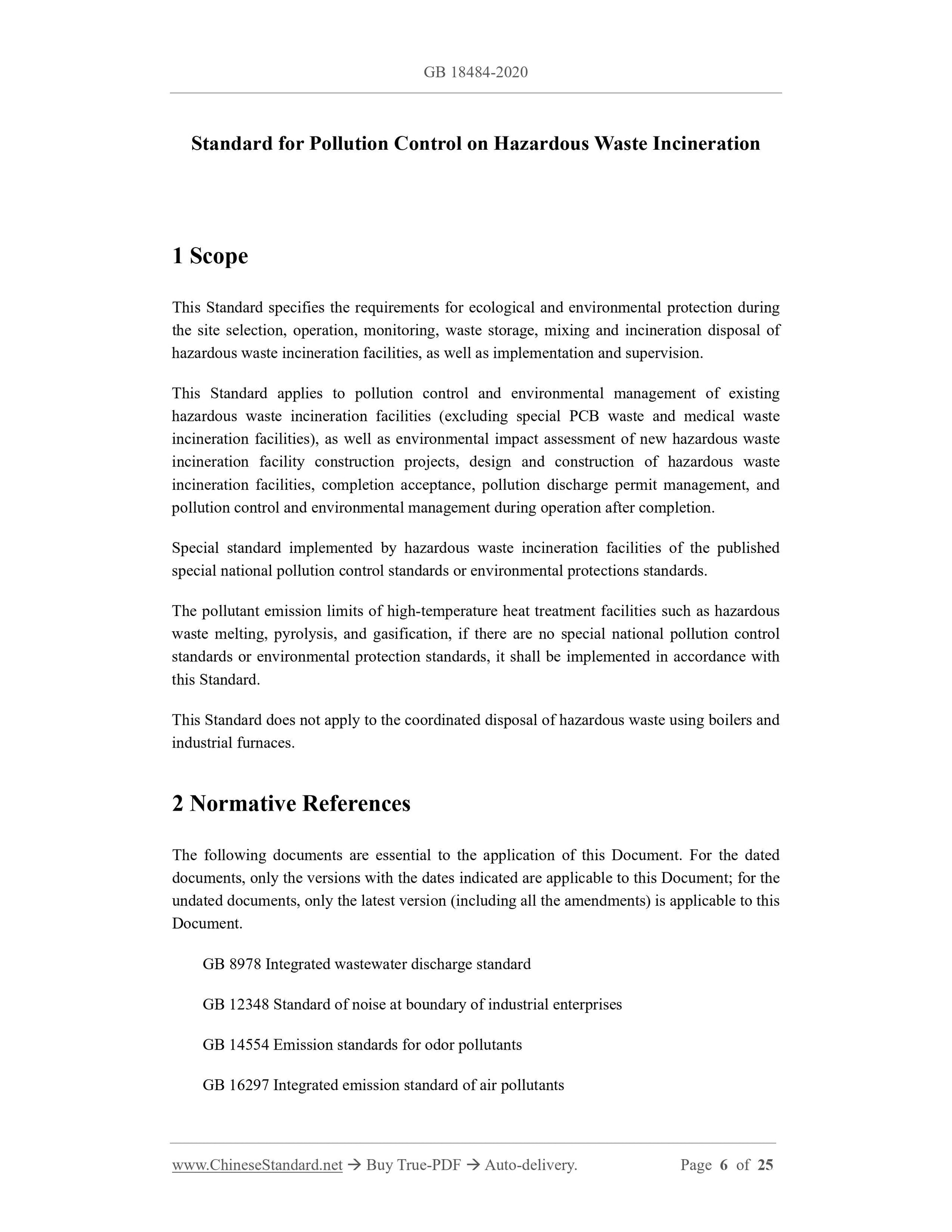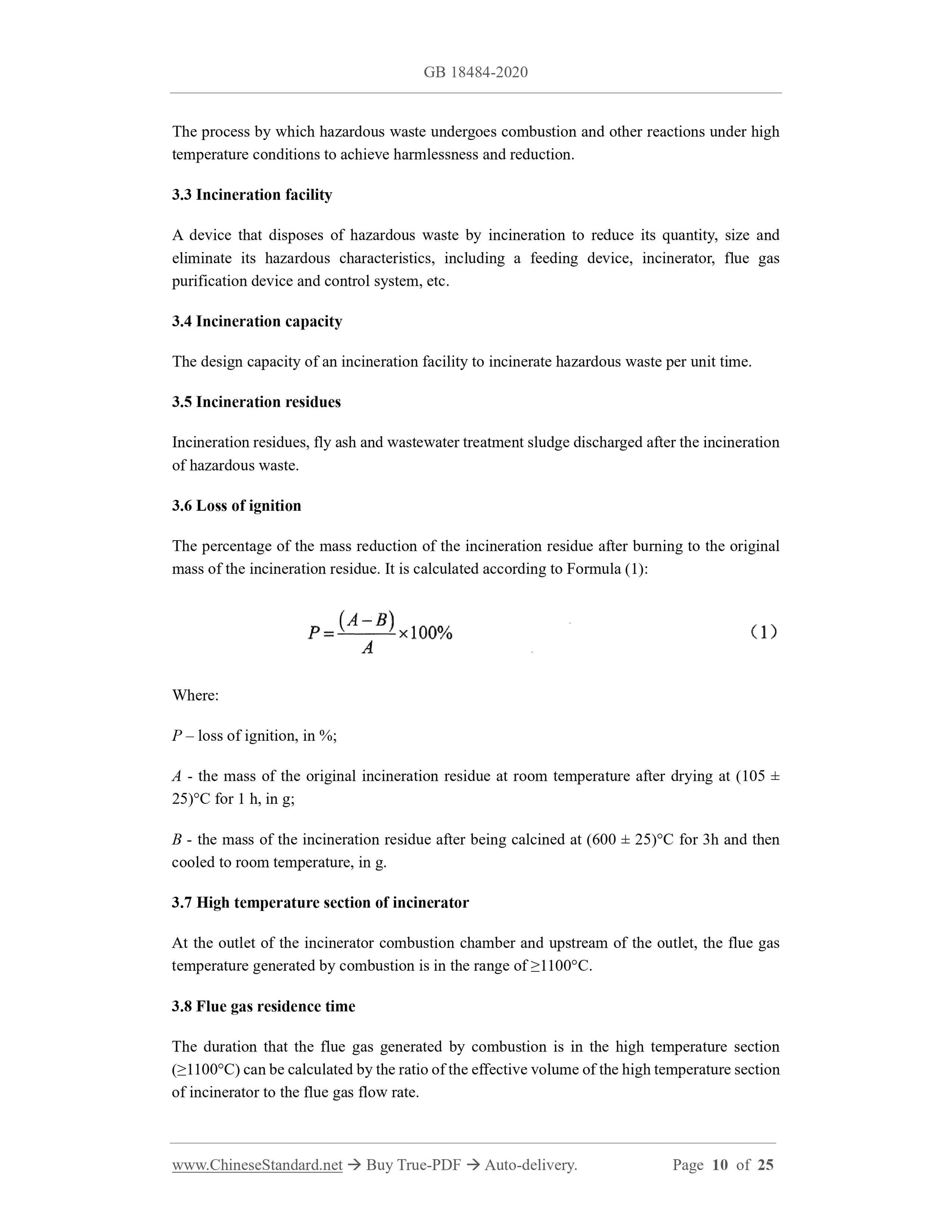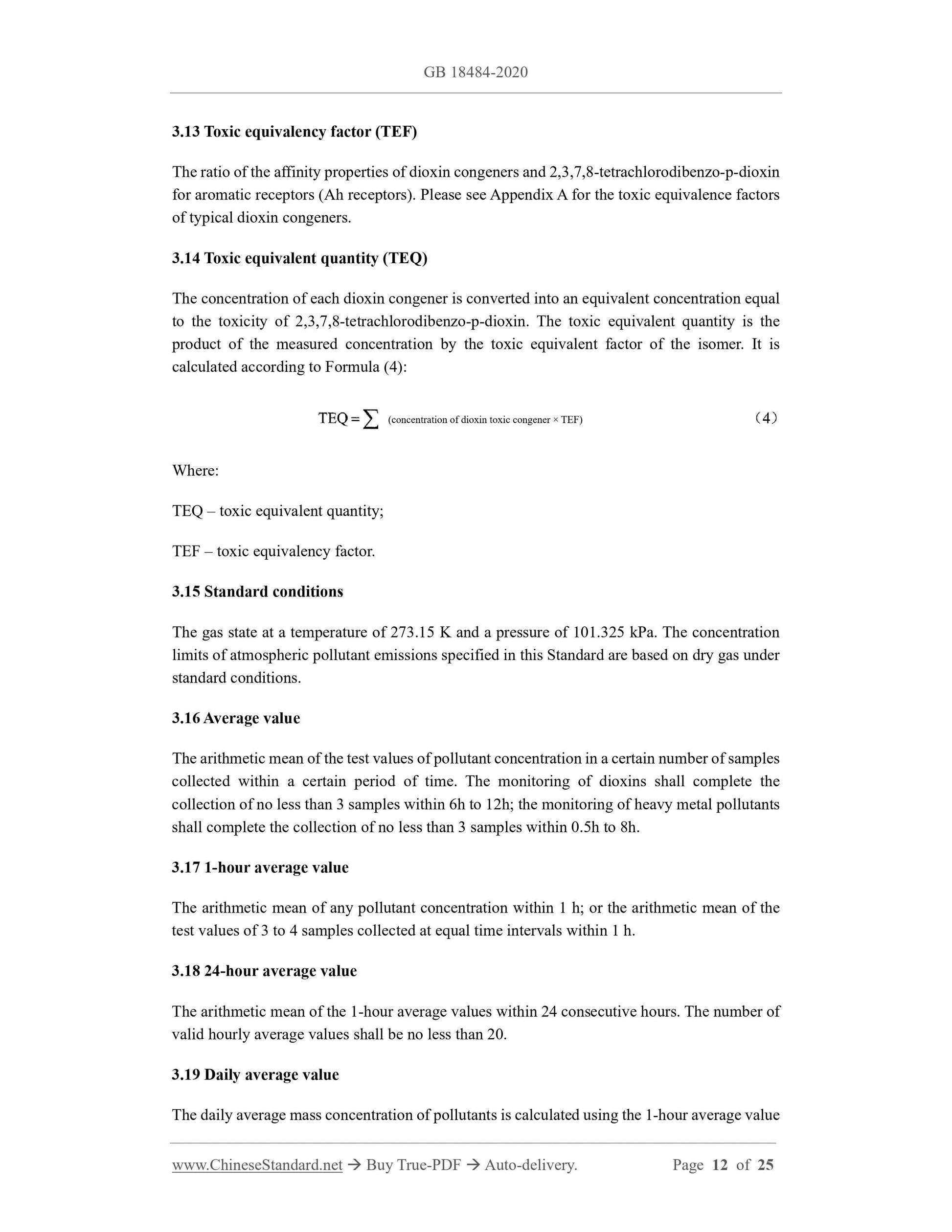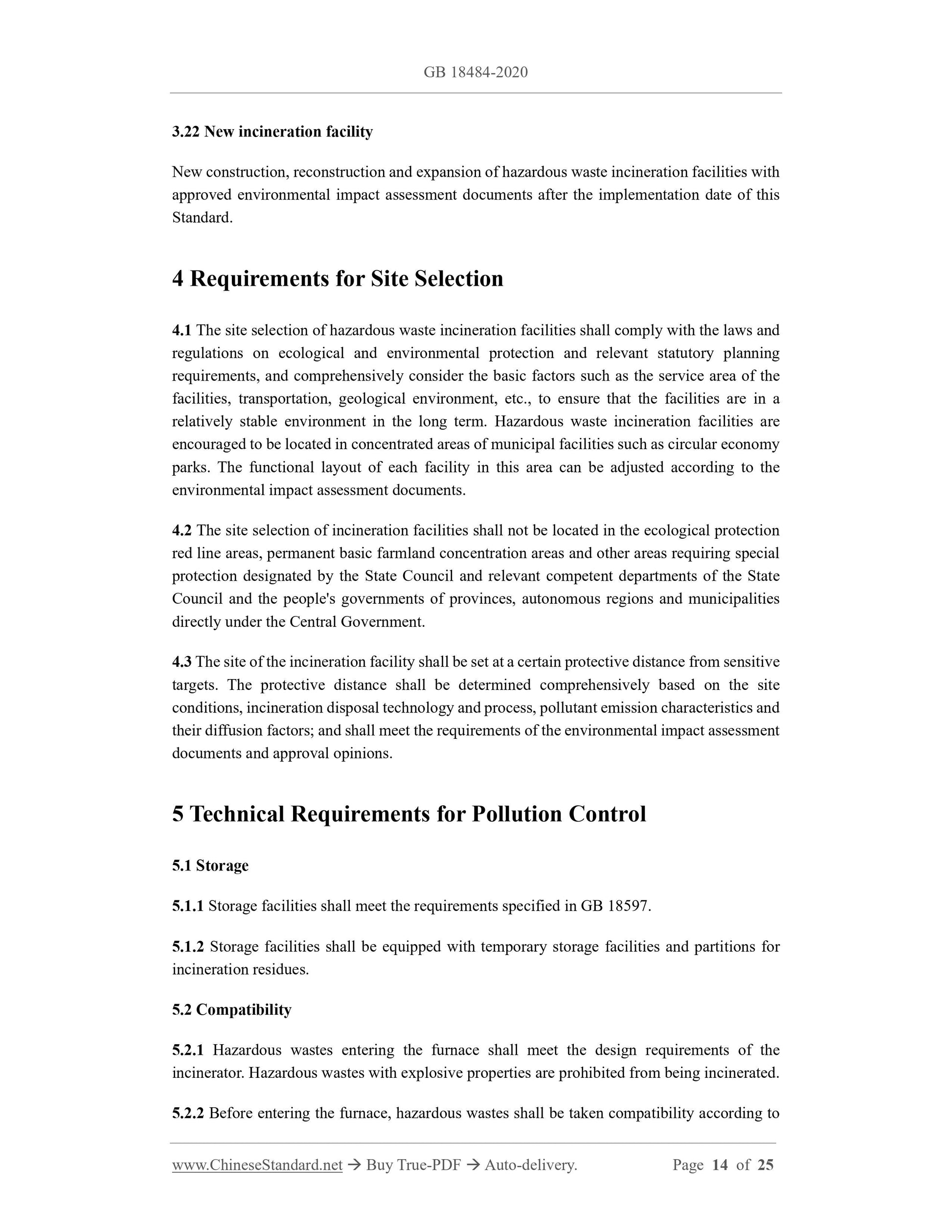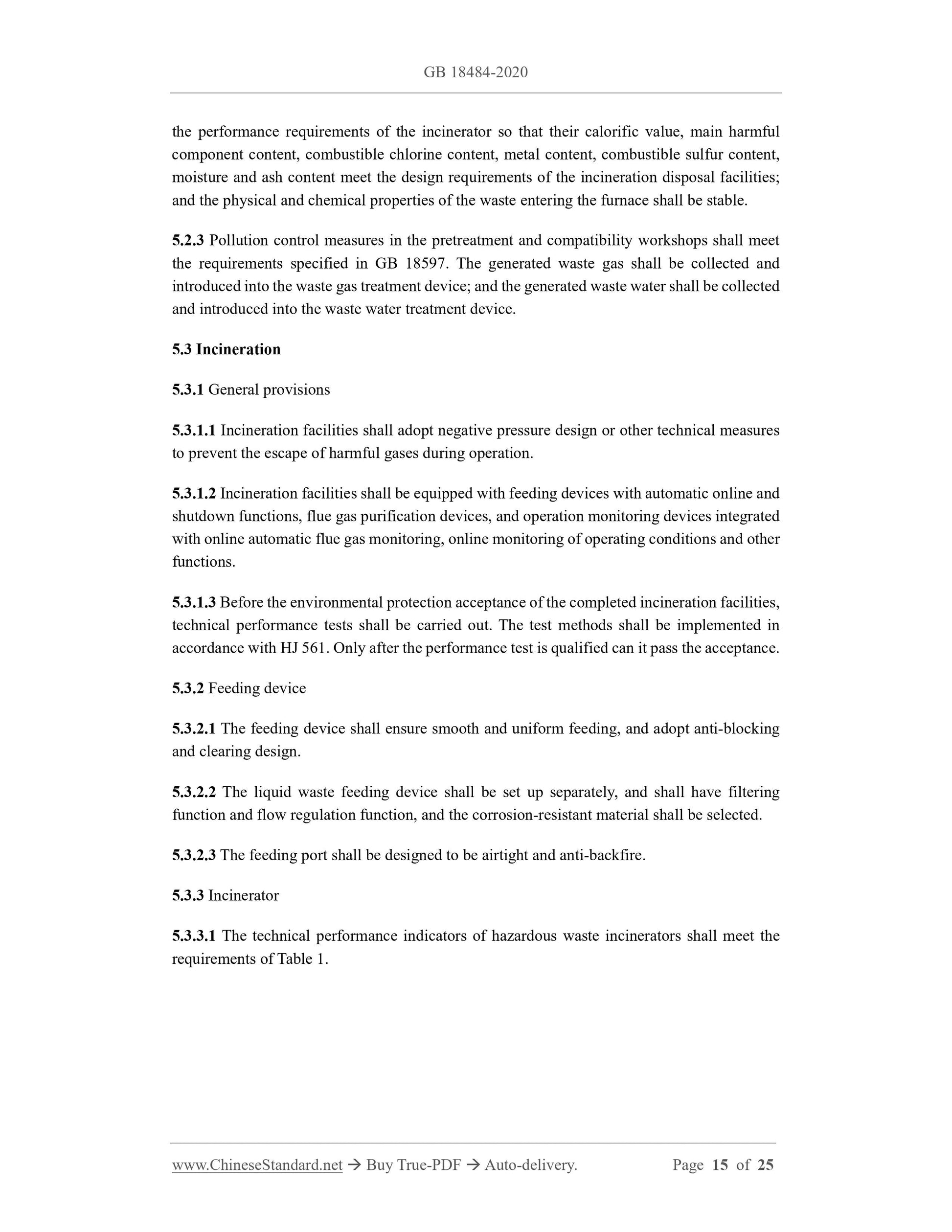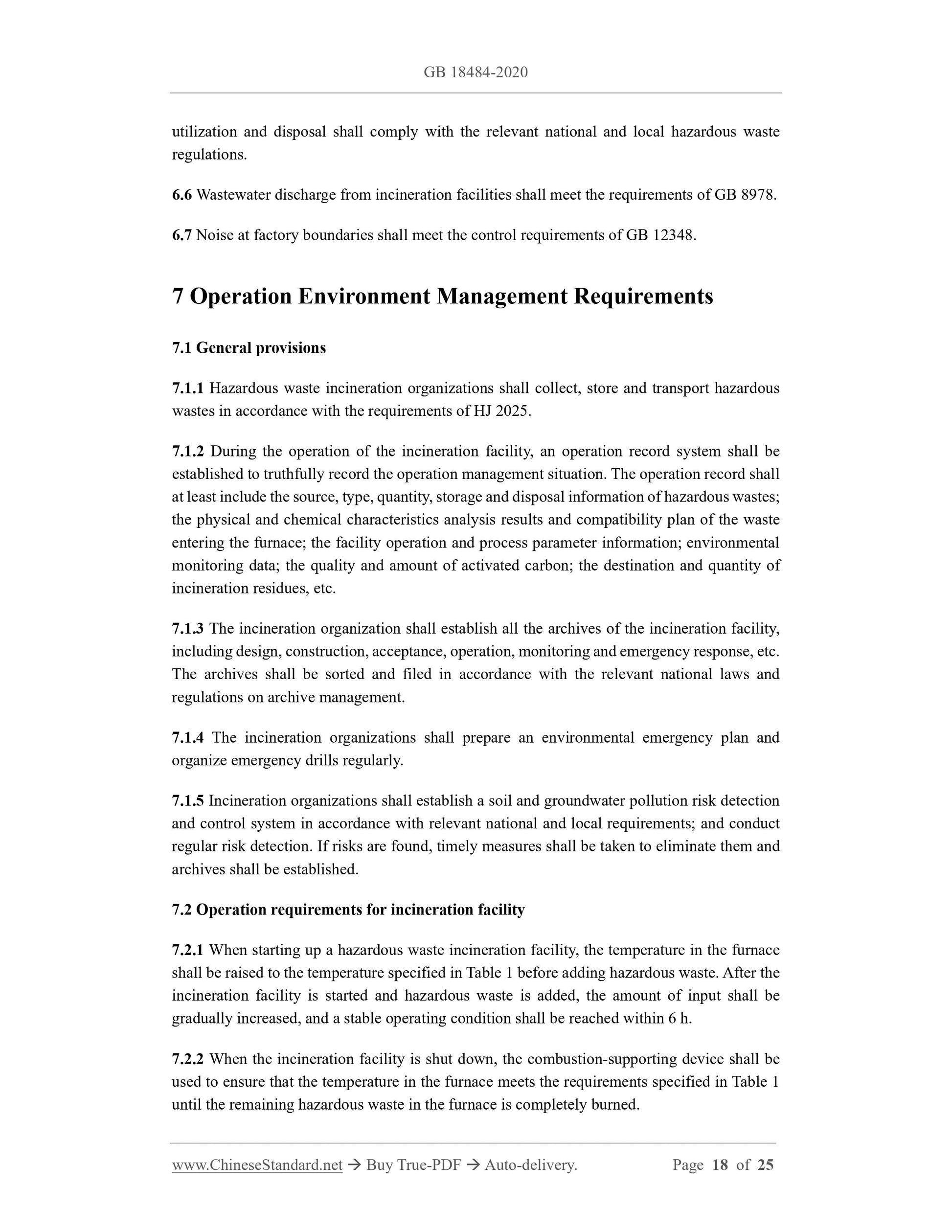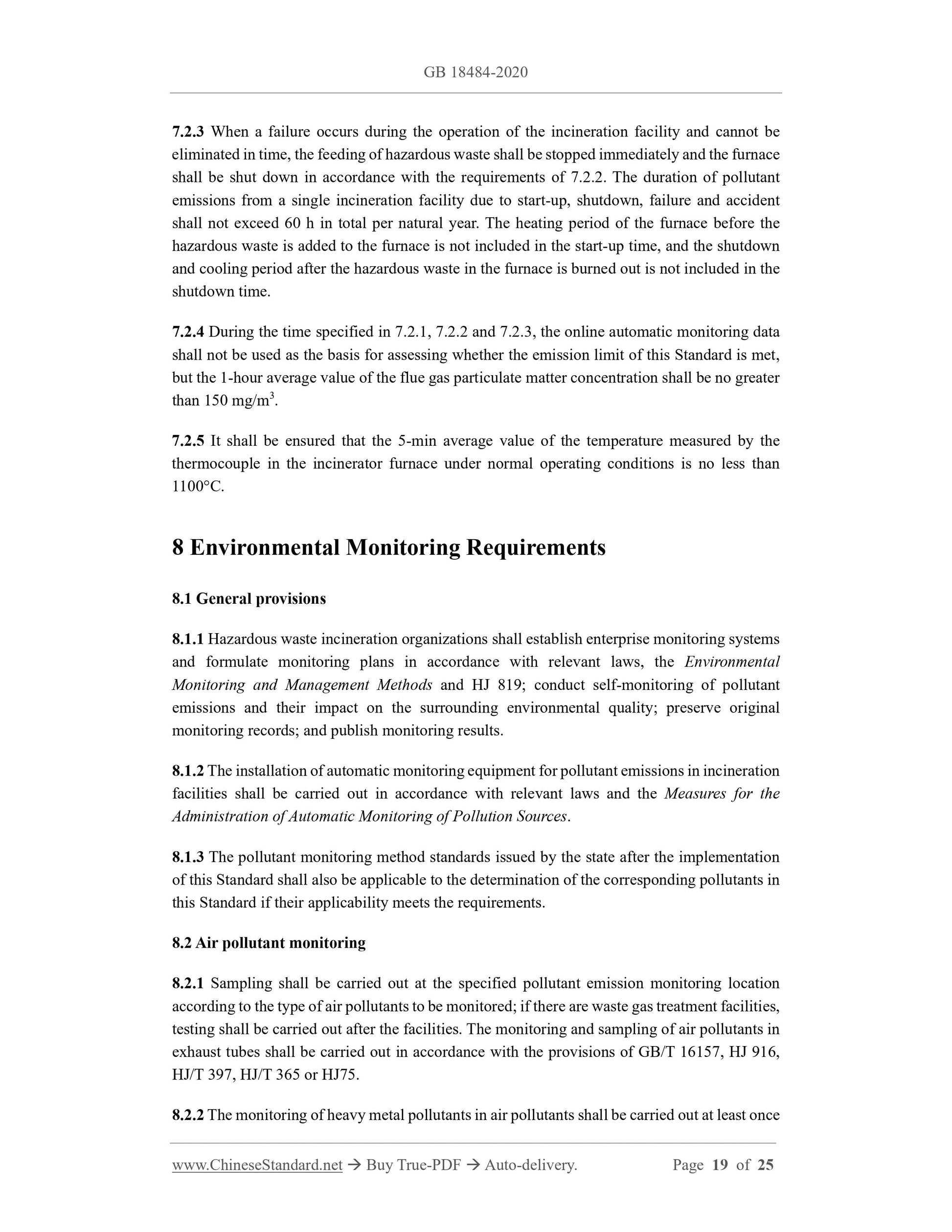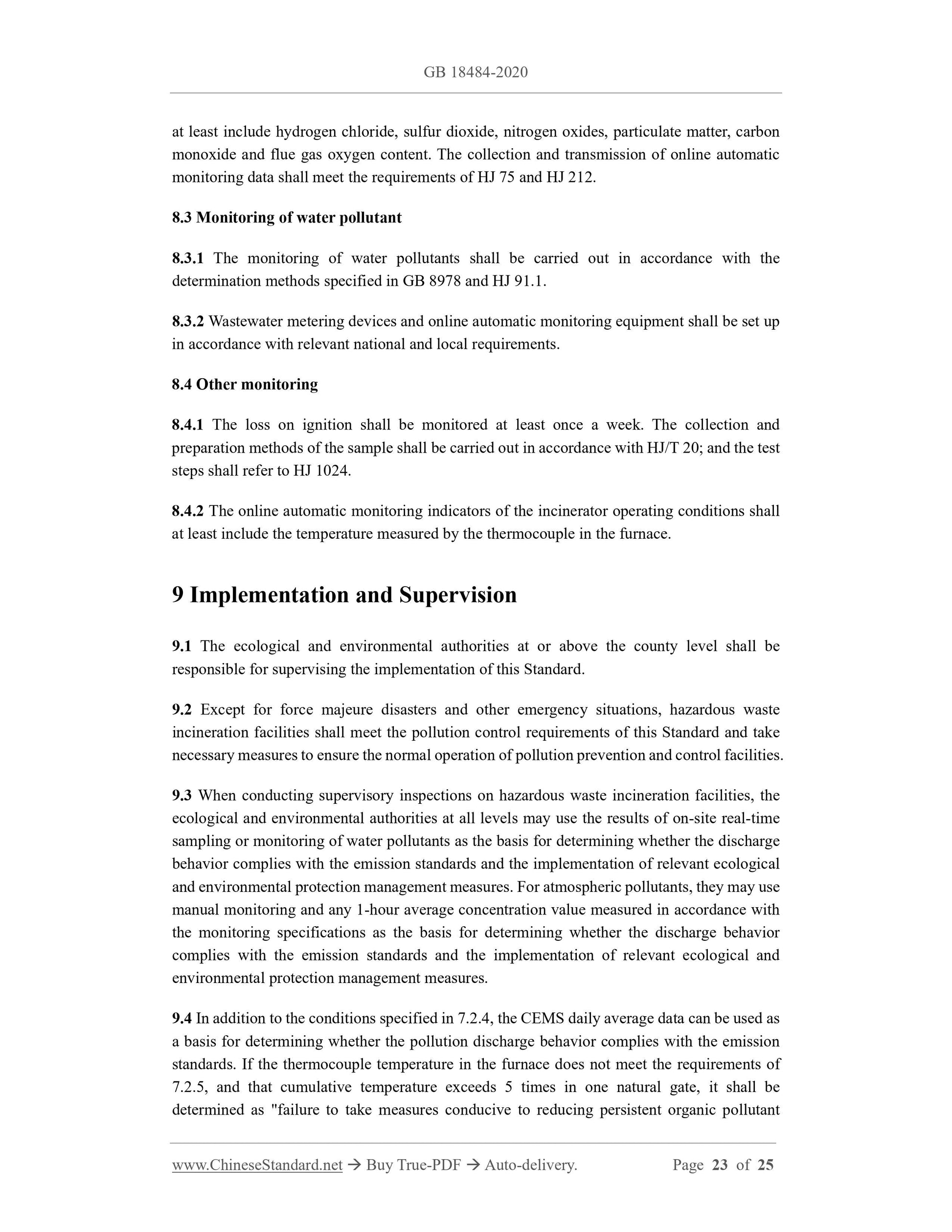1
/
of
10
Sales@ChineseStandard.net (Field Test Asia Pte. Ltd.)
GB 18484-2020 English PDF (GB18484-2020)
GB 18484-2020 English PDF (GB18484-2020)
Regular price
$260.00 USD
Regular price
Sale price
$260.00 USD
Unit price
/
per
Shipping calculated at checkout.
Couldn't load pickup availability
Delivery: 3 seconds. Download true-PDF + Invoice.
Get QUOTATION in 1-minute: Click GB 18484-2020
Historical versions: GB 18484-2020
Preview True-PDF (Reload/Scroll if blank)
GB 18484-2020: Standard for pollution control on hazardous waste incineration
GB 18484-2020
GB
NATIONAL STANDARD OF THE
PEOPLE’S REPUBLIC OF CHINA
ICS 13.030.30
Z 70
Replacing GB 18484-2001
Standard for Pollution Control on Hazardous Waste Incineration
ISSUED ON: DECEMBER 8, 2020
IMPLEMENTED ON: JULY 1, 2021
Issued by: Ministry of Ecology and Environment;
State Administration for Market Regulation.
Table of Contents
Foreword ... 4
1 Scope ... 6
2 Normative References ... 6
3 Terms and Definitions ... 9
4 Requirements for Site Selection ... 14
5 Technical Requirements for Pollution Control ... 14
6 Requirements for Emission Control ... 16
7 Operation Environment Management Requirements ... 18
8 Environmental Monitoring Requirements ... 19
9 Implementation and Supervision ... 23
Appendix A (Normative) Toxic Equivalency Factor (TEF) of PCDDs/PCDFs ... 25
Standard for Pollution Control on Hazardous Waste Incineration
1 Scope
This Standard specifies the requirements for ecological and environmental protection during
the site selection, operation, monitoring, waste storage, mixing and incineration disposal of
hazardous waste incineration facilities, as well as implementation and supervision.
This Standard applies to pollution control and environmental management of existing
hazardous waste incineration facilities (excluding special PCB waste and medical waste
incineration facilities), as well as environmental impact assessment of new hazardous waste
incineration facility construction projects, design and construction of hazardous waste
incineration facilities, completion acceptance, pollution discharge permit management, and
pollution control and environmental management during operation after completion.
Special standard implemented by hazardous waste incineration facilities of the published
special national pollution control standards or environmental protections standards.
The pollutant emission limits of high-temperature heat treatment facilities such as hazardous
waste melting, pyrolysis, and gasification, if there are no special national pollution control
standards or environmental protection standards, it shall be implemented in accordance with
this Standard.
This Standard does not apply to the coordinated disposal of hazardous waste using boilers and
industrial furnaces.
2 Normative References
The following documents are essential to the application of this Document. For the dated
documents, only the versions with the dates indicated are applicable to this Document; for the
undated documents, only the latest version (including all the amendments) is applicable to this
Document.
GB 8978 Integrated wastewater discharge standard
GB 12348 Standard of noise at boundary of industrial enterprises
GB 14554 Emission standards for odor pollutants
GB 16297 Integrated emission standard of air pollutants
The process by which hazardous waste undergoes combustion and other reactions under high
temperature conditions to achieve harmlessness and reduction.
3.3 Incineration facility
A device that disposes of hazardous waste by incineration to reduce its quantity, size and
eliminate its hazardous characteristics, including a feeding device, incinerator, flue gas
purification device and control system, etc.
3.4 Incineration capacity
The design capacity of an incineration facility to incinerate hazardous waste per unit time.
3.5 Incineration residues
Incineration residues, fly ash and wastewater treatment sludge discharged after the incineration
of hazardous waste.
3.6 Loss of ignition
The percentage of the mass reduction of the incineration residue after burning to the original
mass of the incineration residue. It is calculated according to Formula (1):
Where:
P – loss of ignition, in %;
A - the mass of the original incineration residue at room temperature after drying at (105 ±
25)°C for 1 h, in g;
B - the mass of the incineration residue after being calcined at (600 ± 25)°C for 3h and then
cooled to room temperature, in g.
3.7 High temperature section of incinerator
At the outlet of the incinerator combustion chamber and upstream of the outlet, the flue gas
temperature generated by combustion is in the range of ≥1100°C.
3.8 Flue gas residence time
The duration that the flue gas generated by combustion is in the high temperature section
(≥1100°C) can be calculated by the ratio of the effective volume of the high temperature section
of incinerator to the flue gas flow rate.
3.13 Toxic equivalency factor (TEF)
The ratio of the affinity properties of dioxin congeners and 2,3,7,8-tetrachlorodibenzo-p-dioxin
for aromatic receptors (Ah receptors). Please see Appendix A for the toxic equivalence factors
of typical dioxin congeners.
3.14 Toxic equivalent quantity (TEQ)
The concentration of each dioxin congener is converted into an equivalent concentration equal
to the toxicity of 2,3,7,8-tetrachlorodibenzo-p-dioxin. The toxic equivalent quantity is the
product of the measured concentration by the toxic equivalent factor of the isomer. It is
calculated according to Formula (4):
Where:
TEQ – toxic equivalent quantity;
TEF – toxic equivalency factor.
3.15 Standard conditions
The gas state at a temperature of 273.15 K and a pressure of 101.325 kPa. The concentration
limits of atmospheric pollutant emissions specified in this Standard are based on dry gas under
standard conditions.
3.16 Average value
The arithmetic mean of the test values of pollutant concentration in a certain number of samples
collected within a certain period of time. The monitoring of dioxins shall complete the
collection of no less than 3 samples within 6h to 12h; the monitoring of heavy metal pollutants
shall complete the collection of no less than 3 samples within 0.5h to 8h.
3.17 1-hour average value
The arithmetic mean of any pollutant concentration within 1 h; or the arithmetic mean of the
test values of 3 to 4 samples collected at equal time intervals within 1 h.
3.18 24-hour average value
The arithmetic mean of the 1-hour average values within 24 consecutive hours. The number of
valid hourly average values shall be no less than 20.
3.19 Daily average value
The daily average mass concentration of pollutants is calculated using the 1-hour average value
(concentration of dioxin toxic congener × TEF)
3.22 New incineration facility
New construction, reconstruction and expansion of hazardous waste incineration facilities with
approved environmental impact assessment documents after the implementation date of this
Standard.
4 Requirements for Site Selection
4.1 The site selection of hazardous waste incineration facilities shall comply with the laws and
regulations on ecological and environmental protection and relevant statutory planning
requirements, and comprehensively consider the basic factors such as the service area of the
facilities, transportation, geological environment, etc., to ensure that the facilities are in a
relatively stable environment in the long term. Hazardous waste incineration facilities are
encouraged to be located in concentrated areas of municipal facilities such as circular economy
parks. The functional layout of each facility in this area can be adjusted according to the
environmental impact assessment documents.
4.2 The site selection of incineration facilities shall not be located in the ecological protection
red line areas, permanent basic farmland concentration areas and other areas requiring special
protection designated by the State Council ...
Get QUOTATION in 1-minute: Click GB 18484-2020
Historical versions: GB 18484-2020
Preview True-PDF (Reload/Scroll if blank)
GB 18484-2020: Standard for pollution control on hazardous waste incineration
GB 18484-2020
GB
NATIONAL STANDARD OF THE
PEOPLE’S REPUBLIC OF CHINA
ICS 13.030.30
Z 70
Replacing GB 18484-2001
Standard for Pollution Control on Hazardous Waste Incineration
ISSUED ON: DECEMBER 8, 2020
IMPLEMENTED ON: JULY 1, 2021
Issued by: Ministry of Ecology and Environment;
State Administration for Market Regulation.
Table of Contents
Foreword ... 4
1 Scope ... 6
2 Normative References ... 6
3 Terms and Definitions ... 9
4 Requirements for Site Selection ... 14
5 Technical Requirements for Pollution Control ... 14
6 Requirements for Emission Control ... 16
7 Operation Environment Management Requirements ... 18
8 Environmental Monitoring Requirements ... 19
9 Implementation and Supervision ... 23
Appendix A (Normative) Toxic Equivalency Factor (TEF) of PCDDs/PCDFs ... 25
Standard for Pollution Control on Hazardous Waste Incineration
1 Scope
This Standard specifies the requirements for ecological and environmental protection during
the site selection, operation, monitoring, waste storage, mixing and incineration disposal of
hazardous waste incineration facilities, as well as implementation and supervision.
This Standard applies to pollution control and environmental management of existing
hazardous waste incineration facilities (excluding special PCB waste and medical waste
incineration facilities), as well as environmental impact assessment of new hazardous waste
incineration facility construction projects, design and construction of hazardous waste
incineration facilities, completion acceptance, pollution discharge permit management, and
pollution control and environmental management during operation after completion.
Special standard implemented by hazardous waste incineration facilities of the published
special national pollution control standards or environmental protections standards.
The pollutant emission limits of high-temperature heat treatment facilities such as hazardous
waste melting, pyrolysis, and gasification, if there are no special national pollution control
standards or environmental protection standards, it shall be implemented in accordance with
this Standard.
This Standard does not apply to the coordinated disposal of hazardous waste using boilers and
industrial furnaces.
2 Normative References
The following documents are essential to the application of this Document. For the dated
documents, only the versions with the dates indicated are applicable to this Document; for the
undated documents, only the latest version (including all the amendments) is applicable to this
Document.
GB 8978 Integrated wastewater discharge standard
GB 12348 Standard of noise at boundary of industrial enterprises
GB 14554 Emission standards for odor pollutants
GB 16297 Integrated emission standard of air pollutants
The process by which hazardous waste undergoes combustion and other reactions under high
temperature conditions to achieve harmlessness and reduction.
3.3 Incineration facility
A device that disposes of hazardous waste by incineration to reduce its quantity, size and
eliminate its hazardous characteristics, including a feeding device, incinerator, flue gas
purification device and control system, etc.
3.4 Incineration capacity
The design capacity of an incineration facility to incinerate hazardous waste per unit time.
3.5 Incineration residues
Incineration residues, fly ash and wastewater treatment sludge discharged after the incineration
of hazardous waste.
3.6 Loss of ignition
The percentage of the mass reduction of the incineration residue after burning to the original
mass of the incineration residue. It is calculated according to Formula (1):
Where:
P – loss of ignition, in %;
A - the mass of the original incineration residue at room temperature after drying at (105 ±
25)°C for 1 h, in g;
B - the mass of the incineration residue after being calcined at (600 ± 25)°C for 3h and then
cooled to room temperature, in g.
3.7 High temperature section of incinerator
At the outlet of the incinerator combustion chamber and upstream of the outlet, the flue gas
temperature generated by combustion is in the range of ≥1100°C.
3.8 Flue gas residence time
The duration that the flue gas generated by combustion is in the high temperature section
(≥1100°C) can be calculated by the ratio of the effective volume of the high temperature section
of incinerator to the flue gas flow rate.
3.13 Toxic equivalency factor (TEF)
The ratio of the affinity properties of dioxin congeners and 2,3,7,8-tetrachlorodibenzo-p-dioxin
for aromatic receptors (Ah receptors). Please see Appendix A for the toxic equivalence factors
of typical dioxin congeners.
3.14 Toxic equivalent quantity (TEQ)
The concentration of each dioxin congener is converted into an equivalent concentration equal
to the toxicity of 2,3,7,8-tetrachlorodibenzo-p-dioxin. The toxic equivalent quantity is the
product of the measured concentration by the toxic equivalent factor of the isomer. It is
calculated according to Formula (4):
Where:
TEQ – toxic equivalent quantity;
TEF – toxic equivalency factor.
3.15 Standard conditions
The gas state at a temperature of 273.15 K and a pressure of 101.325 kPa. The concentration
limits of atmospheric pollutant emissions specified in this Standard are based on dry gas under
standard conditions.
3.16 Average value
The arithmetic mean of the test values of pollutant concentration in a certain number of samples
collected within a certain period of time. The monitoring of dioxins shall complete the
collection of no less than 3 samples within 6h to 12h; the monitoring of heavy metal pollutants
shall complete the collection of no less than 3 samples within 0.5h to 8h.
3.17 1-hour average value
The arithmetic mean of any pollutant concentration within 1 h; or the arithmetic mean of the
test values of 3 to 4 samples collected at equal time intervals within 1 h.
3.18 24-hour average value
The arithmetic mean of the 1-hour average values within 24 consecutive hours. The number of
valid hourly average values shall be no less than 20.
3.19 Daily average value
The daily average mass concentration of pollutants is calculated using the 1-hour average value
(concentration of dioxin toxic congener × TEF)
3.22 New incineration facility
New construction, reconstruction and expansion of hazardous waste incineration facilities with
approved environmental impact assessment documents after the implementation date of this
Standard.
4 Requirements for Site Selection
4.1 The site selection of hazardous waste incineration facilities shall comply with the laws and
regulations on ecological and environmental protection and relevant statutory planning
requirements, and comprehensively consider the basic factors such as the service area of the
facilities, transportation, geological environment, etc., to ensure that the facilities are in a
relatively stable environment in the long term. Hazardous waste incineration facilities are
encouraged to be located in concentrated areas of municipal facilities such as circular economy
parks. The functional layout of each facility in this area can be adjusted according to the
environmental impact assessment documents.
4.2 The site selection of incineration facilities shall not be located in the ecological protection
red line areas, permanent basic farmland concentration areas and other areas requiring special
protection designated by the State Council ...
Share
